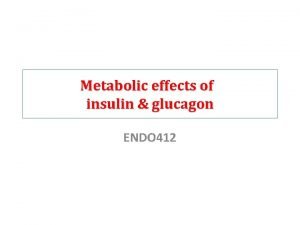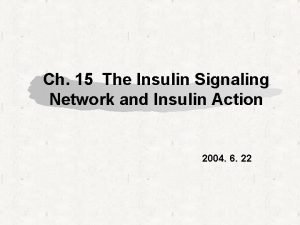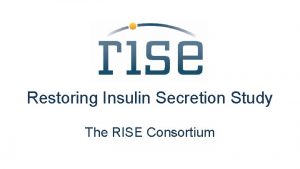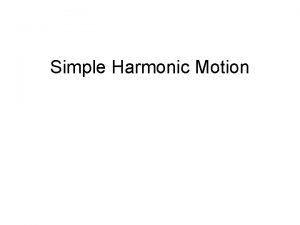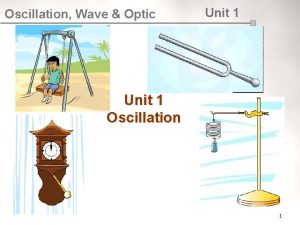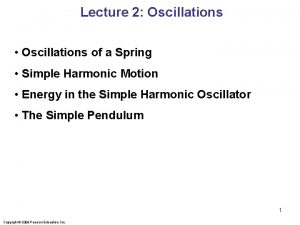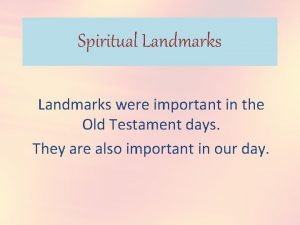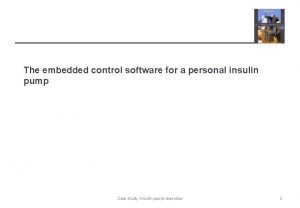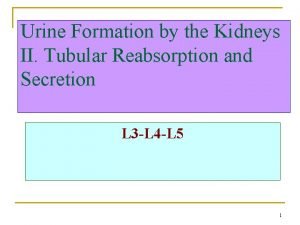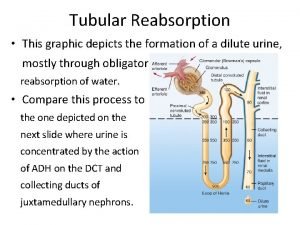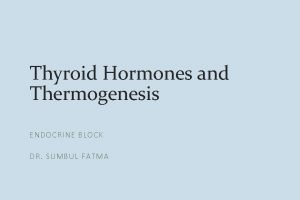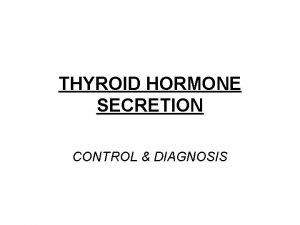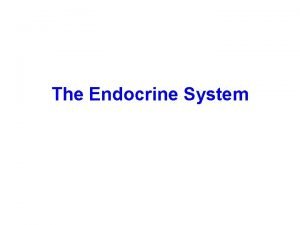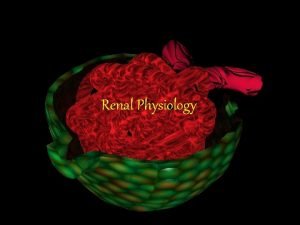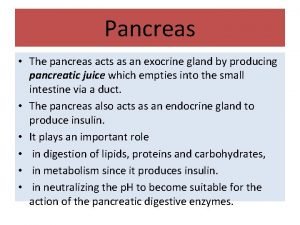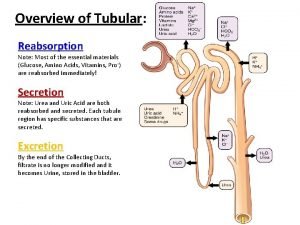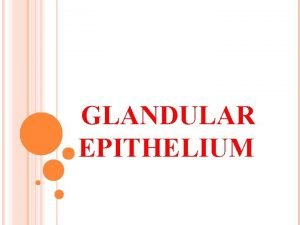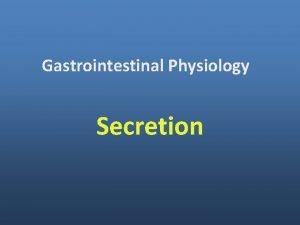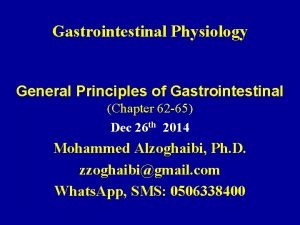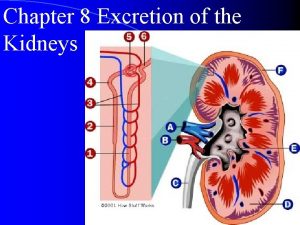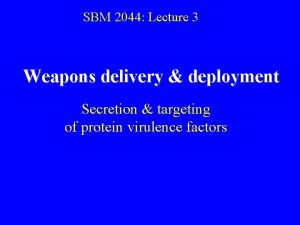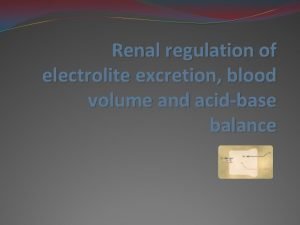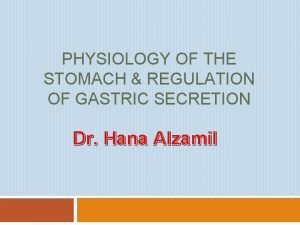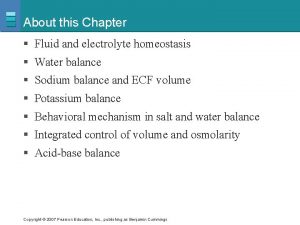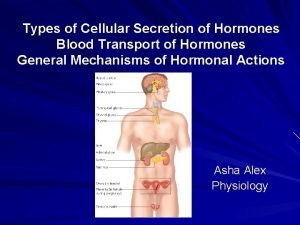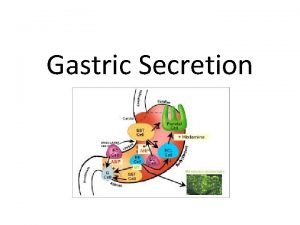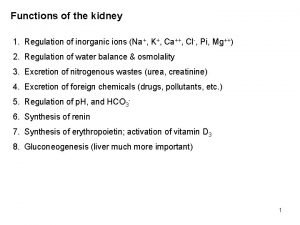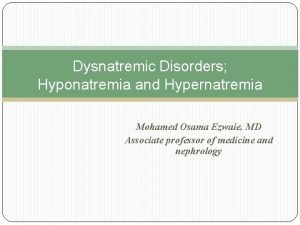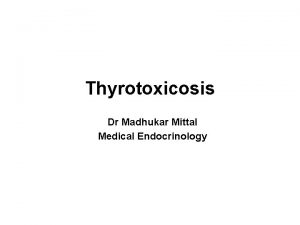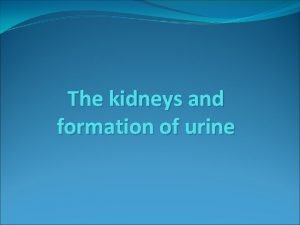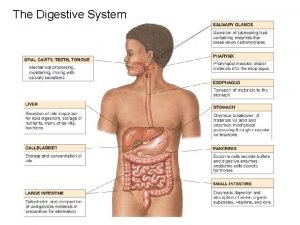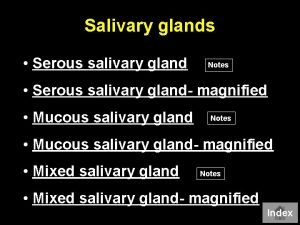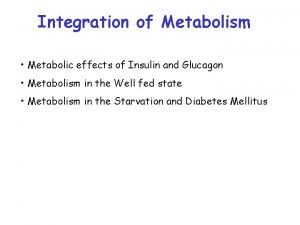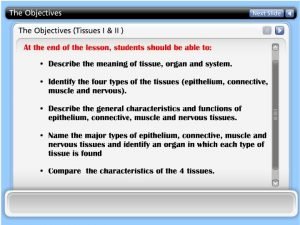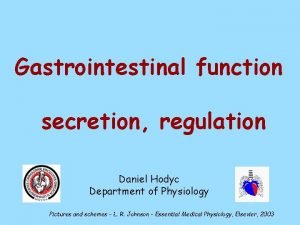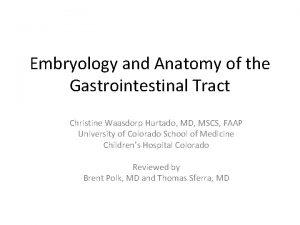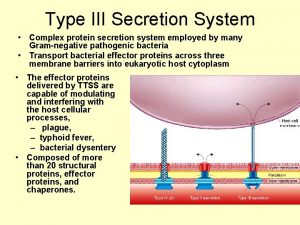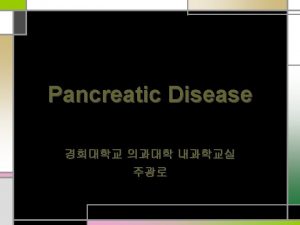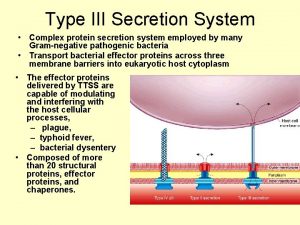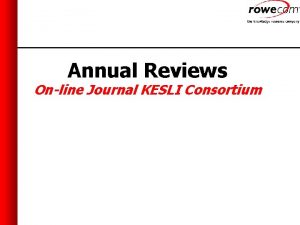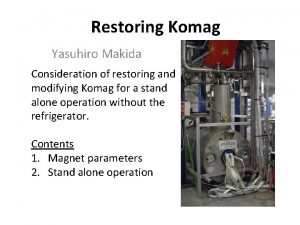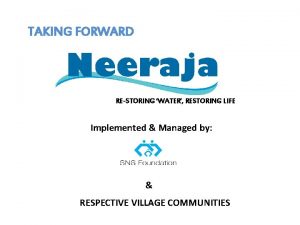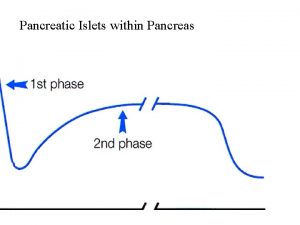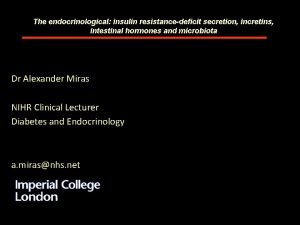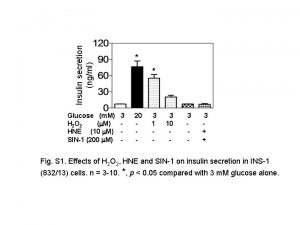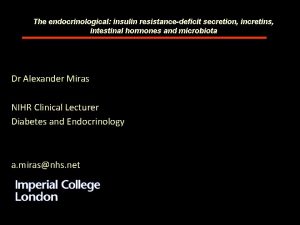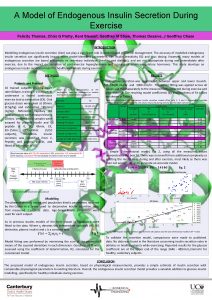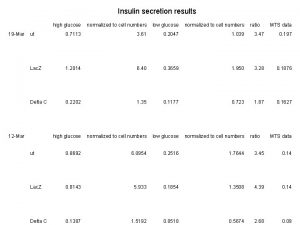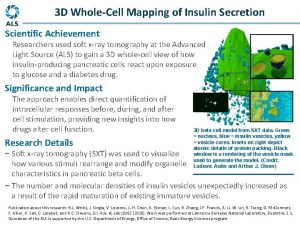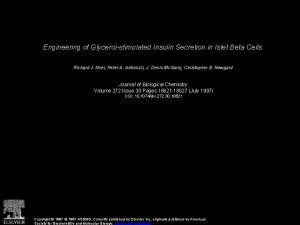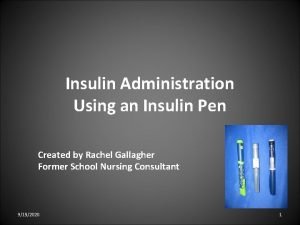Restoring Insulin Secretion Study The RISE Consortium Is
































































- Slides: 64

Restoring Insulin Secretion Study The RISE Consortium

Is it possible to intervene aggressively to prevent the loss of β-cell function? Fasting glucose (mg/d. L) <100 Normal <140 100 - 125 Impaired 140 - 199 2 -hour glucose (mg/d. L) ≥ 126 Diabetes ≥ 200

Background Study Designs – Pediatric Medication, Adult Medication, and Adult Surgery Protocols

Restoring Insulin Secretion (RISE) Studies Proof-of-Principle Studies Comparing medications Comparing surgical vs. medical intervention Pediatric Medication Study Adult Surgery (Beta. Fat) Study (10 -19 years) (20 -65 years) (22 -65 years) The RISE Consortium: Diabetes Care 37: 780 -788; 2014

Restoring Insulin Secretion (RISE) Studies Pr i Re mary su lts Proof-of-Principle Studies Comparing medications Comparing surgical vs. medical intervention Pediatric Medication Study Adult Surgery (Beta. Fat) Study (10 -19 years) (20 -65 years) (22 -65 years) The RISE Consortium: Diabetes Care 37: 780 -788; 2014

RISE Primary Questions In participants with impaired glucose tolerance or recently diagnosed type 2 diabetes: Pediatric and Adult Medication Studies Can β-cell function be preserved or improved during 12 months of active treatment and maintained for 3 months following the withdrawal of therapy? Adult Surgery Study Can β-cell function be preserved or improved 24 months following laparoscopic banding weight loss surgery? The RISE Consortium: Diabetes Care 37: 780 -788; 2014

Co-Primary Outcomes Two β-cell response measures from the hyperglycemic clamp, adjusted for insulin sensitivity: 1. Steady-State C-peptide Response Mean steady-state C-peptide concentration at glucose ~200 mg/d. L (second phase response) 2. ACPRmax Arginine-induced acute C-peptide response at maximal glycemic potentiation (glucose >450 mg/d. L; β-cell secretory capacity) The RISE Consortium: Diabetes Care 37: 780 -788; 2014

Inclusion Criteria Pediatric Medication Adult Surgery 10 -19 20 -65 22 -65 ≥ 85 th %ile but ≤ 50 kg/m 2 25 -50 kg/m 2 30 -40 kg/m 2 Fasting glucose ≥ 90 mg/d. L 95 -125 mg/d. L ≥ 90 mg/d. L 2 -hour OGTT glucose ≥ 140 mg/d. L Diabetes duration <6 months <1 year Metformin <6 months Insulin <2 weeks Naïve Criteria Age (years) Tanner stage Body mass index Diabetes medication status Hb. A 1 c 2 or above ≤ 8. 0% (drug naïve) ≤ 7. 5% (on metformin <3 months) ≤ 7. 0% (on metformin 3 -6 months) The RISE Consortium: Diabetes Care 37: 780 -788; 2014 ≤ 7. 0%

Randomized Study Interventions Pediatric Medication Adult Surgery Metformin (blinded) Metformin Glargine Metformin Laparoscopic banding Liraglutide + Metformin Placebo (blinded) The RISE Consortium: Diabetes Care 37: 780 -788; 2014

Randomized Study Interventions Pediatric Medication Adult Surgery Metformin (blinded) Metformin Glargine Metformin Laparoscopic banding Liraglutide + Metformin Placebo (blinded) The RISE Consortium: Diabetes Care 37: 780 -788; 2014

Primary Outcome Collection Medication Study Protocols: Study Phases and Key Time Points Hyperglycemic Clamp OGTT Screening Run-in (3 weeks) Baseline Randomization The RISE Consortium: Diabetes Care 37: 780 -788; 2014 Hyperglycemic Clamp OGTT Active Treatment (12 months) Washout (3 months) 12 months 15 months

Hyperglycemic Clamp OGTT Screening Baseline Randomization The RISE Consortium: Diabetes Care 37: 780 -788; 2014 Hyperglycemic Clamp OGTT Primary Outcome Collection Adult Surgery Protocol: Study Phases and Key Time Points Hyperglycemic Clamp OGTT Active Treatment (24 months) 12 months 24 months

Timing of Metabolic Testing: Comparisons Between Protocols Baseline 12 months 15 months 24 months (prior to Rx) (on Rx) (3 months off Rx) (on Rx) Clamp Pediatric Medication OGTT X X X Clamp Adult Medication OGTT X X X Clamp X X X OGTT X X X Adult Surgery The RISE Consortium: Diabetes Care 37: 780 -788; 2014

Power and Sample Size Considerations • β-cell function co-primary outcomes (steady-state C-peptide and ACPRmax) analyzed separately each with a type I error of =0. 05 • Power set at 80% • Pediatric Medication Study only: powered using a 1 -sided type I error of =0. 05 in favor of the glargine followed by metformin intervention The RISE Consortium: Diabetes Care 37: 780 -788; 2014

Sample Size Pediatric Medication Adult Surgery 39 per arm (78 total) 56 per arm (224 total) 35 per arm (70 total) 10% 20% Recruitment goal 90 255 88 Randomized 91 267 88 July 2017 January 2019 June 2018 Sample size Expected loss to followup Final primary outcome visit The RISE Consortium: Diabetes Care 37: 780 -788; 2014

Baseline Data Comparing Youth and Adults Contrasts in Beta-cell Function Based on the Hyperglycemic Clamp and OGTT

Objective To compare insulin sensitivity and β-cell responses in youth vs. adults with impaired glucose tolerance or drug-naïve, recently diagnosed type 2 diabetes using: • Hyperglycemic clamp • Oral glucose tolerance test (OGTT)

Two-step Hyperglycemic Clamp Protocol β-cell Responses Glucose (mg/d. L) 600 Acute C-peptide Response to Arginine bolus Arginine (ACPRmax) 500 400 Steady-state C-peptide 300 200 100 0 . Variable rate 20% dextrose infusion Acute C-peptide Response to Glucose. (ACPRg). . . -20 -10 0 . 160 170 180 10 20 30 40 50 60 70 80 90 100 110 120 130 140 150 Glucose bolus The RISE Consortium: Diabetes Care 37: 780 -788; 2014 Time (minutes) Glucose bolus

Clamp-Glucose and C-Peptide Profiles in Youth vs. Adults Glucose The RISE Consortium: Diabetes Care 41: 1696 -1706; 2018 C-peptide

C-Peptide Responses in Youth vs. Adults Youth ACPRmax p<0. 001 Adults Adapted from The RISE Consortium: Diabetes Care 41: 1696 -1706; 2018 Youth Adults ACPRmax (ng/m. L) ACPRg (ng/m. L) p<0. 001 Steady State C-Peptide Steady-state C-peptide (ng/m. L) ACPRg Youth Adults

Relationship of Insulin Sensitivity with the Acute C-peptide Response to Glucose in Youth and Adults ACPRg (ng/ml) Log ACPRg M/I (x 10 -3 mg/kg/min per µU/m. L) Slope p<0. 001 The RISE Consortium: Diabetes Care 41: 1696 -1706; 2018 Group * Slope p=ns

Relationship of Insulin Sensitivity with Steady-State C-peptide in Youth and Adults Slope p<0. 001 The RISE Consortium: Diabetes Care 41: 1696 -1706; 2018 Group * Slope p=ns

Relationship of Insulin Sensitivity with the Acute C-peptide Response to Arginine in Youth and Adults ACPRmax (ng/m. L) ACPRmax M/I (x 10 -3 mg/kg/min per µU/m. L) Slope p<0. 001 The RISE Consortium: Diabetes Care 41: 1696 -1706; 2018 Group * Slope p=ns

OGTT Glucose, C-peptide and Insulin Profiles in Youth vs. Adults Glucose The RISE Consortium: Diabetes Care 41: 1707 -1716; 2018 C-peptide Insulin

OGTT-Derived Measurements – Insulin sensitivity: 1/fasting insulin (1/FI) – Early C-peptide response: [∆C(30 -0)/∆G(30 -0)] The RISE Consortium: Diabetes Care 41: 1707 -1716; 2018

OGTT-Derived Insulin Sensitivity and Early C-peptide Response in Youth vs. Adults p<0. 001 Youth Early C-peptide Response (ng/ml) 1/Fasting Insulin (1/mu/m. L) Insulin Sensitivity Adults Adapted from The RISE Consortium: Diabetes Care 41: 1707 -1716; 2018 p<0. 001 Youth Adults

Relationship of 1/Fasting Insulin and Early C-peptide Response in Youth and Adults Early C-peptide Response (ng/ml) Log Early C-peptide Response 1/Fasting Insulin (1/(µU/m. L)) Slope p<0. 001 The RISE Consortium: Diabetes Care 41: 1707 -1716; 2018 Group * Slope p=ns

Summary: Youth vs. Adults • Insulin sensitivity was ~50% lower in youth than comparably overweight dysglycemic adults. • Acute C-peptide responses to intravenous glucose and non-glucose secretagogue arginine were greater in youth. • Similarly, after oral glucose ingestion, C-peptide and insulin responses were greater in youth despite similar glucose excursions. • These compensatory responses for the lower insulin sensitivity were proportionately greater in youth than adults.

Conclusions • At all levels of insulin sensitivity, youth in RISE have hyperresponsive β-cells; this may represent a fundamental difference in the pathogenesis of type 2 diabetes between youth and adults. • This difference may explain the different rates at which diabetes develops and progresses in youth and adults.

RISE Pediatric Medication Study Comparisons of Baseline Data by Intervention Arms

RISE Pediatric Medication Study Question In youth with IGT or recently diagnosed type 2 diabetes, can β-cell function be preserved or improved during 12 months of pharmacologic intervention, and maintained for 3 months following the withdrawal of therapy?

Rationale for Use of Metformin 1) Metformin and insulin are the only medications approved for treating type 2 diabetes in youth. 2) In adults with IGT or recently diagnosed type 2 diabetes, metformin slows progression of dysglycemia by improving β-cell function. Diabetes Prevention Program Research Group: Diabetes 54: 2404 -14; 2005 ADOPT Study Group: Diabetes 60: 1552 -60; 2011

Study Interventions Randomized, unblinded, proof-of-principle trial comparing two treatment regimens: Glargine followed by metformin – 3 months of insulin glargine alone, titrated to fasting selfmonitored blood glucose (SMBG) of 80 -90 mg/d. L – 9 months of metformin alone, titrated to 1, 000 mg twice daily Metformin only – 12 months of metformin, titrated to 1, 000 mg twice daily The RISE Consortium: Diabetes Care 37: 780 -788; 2014

Inclusion Criteria Age Tanner stage BMI Diabetes duration Diabetes medication status Fasting plasma glucose 2 -hour OGTT glucose Hb. A 1 c Autoantibodies Eligibility 10 -19 years ≥ 2 ≥ 85 th %ile but ≤ 50 kg/m 2 <6 months Metformin <6 months; Insulin <2 weeks ≥ 90 mg/d. L ≥ 140 mg/d. L ≤ 8. 0% (drug naïve) ≤ 7. 5% (on metformin <3 months) ≤ 7. 0% (on metformin 3 -6 months) Negative IA-2, GAD

Baseline Characteristics Criteria Glargine followed by metformin (n=44) Metformin alone (n=47) Female 27 (61%) 38 (81%) Age (years) 14. 9 2. 0 13. 9 2. 1* 72% 53% White 13 (29%) 12 (25%) Black 14 (32%) 9 (19%) Hispanic 14 (32%) 20 (43%) Diagnosis of diabetes 18 (41%) 19 (40%) Tanner Stage 5 * p=0. 03 for group difference The RISE Consortium: Diabetes Care 41: 1717 -1725; 2018

Baseline Characteristics Glargine followed by metformin (n=44) Metformin alone (n=47) Weight (kg) 102. 0 ± 25. 7 97. 7 ± 23. 3 BMI (kg/m 2) 36. 5 ± 6. 4 36. 9 ± 6. 4 BMI percentile 98. 4 ± 2. 5 98. 8 ± 1. 3 Systolic BP (mm Hg) 120. 7 ± 7. 8 119. 5 ± 8. 7 Diastolic BP (mm Hg) 67. 6 ± 7. 7 70. 1 ± 7. 9 Hypertension (n, %) 9 (20. 5%) 15 (31. 9%) LDL (mg/d. L) 87. 1 ± 31 80. 3 ± 24. 4 HDL (mg/d. L) 39. 5 ± 9. 8 40. 2 ± 8 98. 5 (34. 8, 278. 4) 103. 6 (39. 6, 271. 2) Criteria Triglycerides (mg/d. L)

Baseline Glucose, C-peptide and Insulin Profiles Glucose The RISE Consortium: Diabetes Care 41: 1717 -1725; 2018 C-peptide Insulin

Baseline Hyperglycemic Clamp Results: Insulin Sensitivity (M/I) The RISE Consortium: Diabetes Care 41: 1717 -1725; 2018

Baseline Hyperglycemic Clamp Results: β-cell Response Measures The RISE Consortium: Diabetes Care 41: 1717 -1725; 2018

Summary In this cohort of youth with impaired glucose tolerance or recently diagnosed type 2 diabetes, the two intervention groups were well matched at baseline.

RISE Pediatric Medication Study Primary Outcomes

Primary Outcome Collection Pediatric Medication Study Protocol: Study Phases and Key Time Points Hyperglycemic Clamp OGTT Screening Run-in (3 weeks) Baseline Randomization The RISE Consortium: Diabetes Care 37: 780 -788; 2014 Hyperglycemic Clamp OGTT Active Treatment (12 months) Washout (3 months) 12 months 15 months

Follow-up Allocation Enrollment CONSORT Diagram Assessed for Eligibility (n=236) Ineligible (n=127) Began Run-in Period (n=109) Randomized (n=91) Glargine followed by Metformin (n=44) Metformin Alone (n=47) Month 12 Visit (n=41) Month 12 Visit (n=45) Primary Outcome Visit Month 15 Visit (n=41) Primary Outcome Visit Month 15 Visit (n=43) The RISE Consortium: Diabetes Care 41: 1717 -1725; 2018

RISE Pediatric Medication Study Treatment Arms • Metformin alone: – Metformin titrated over 4 weeks from 500 mg/day to 1, 000 mg twice daily – Dose modified if necessary due to GI symptoms • Glargine followed by metformin: – Once daily insulin glargine, titrated twice weekly over one month based on SMBG to goal of 80 -90 mg/d. L – Glargine discontinued and metformin titrated after 3 months The RISE Consortium: Diabetes Care 37: 780 -788; 2014

Medication Adherence • Metformin alone – Metformin adherence (pill count): • 86% of participants were >80% adherent over 12 months • 87% were taking 2, 000 mg/day at 12 months • Glargine followed by metformin – Glargine adherence (residual volume): • 68% of participants were >80% adherent over 3 months – Metformin adherence (pill count): • 89% of participants were >80% adherent over 9 months • 90% were taking 2, 000 mg/day at 12 months The RISE Consortium: Diabetes Care 41: 1717 -1725; 2018

Glargine Titration Percent at SMBG goal of 80 -90 mg/d. L Weeks during glargine use The RISE Consortium: Diabetes Care 41: 1717 -1725; 2018 Glargine (units/kg/day) 30 1 0. 8 0. 6 0. 4 0. 2 78 910 11 -1 2 56 34 12 A B 78 910 11 -1 2 56 Weeks during glargine use S 0 20 34 78 910 11 -1 2 56 34 12 A S 80 40 12 90 50 S 100 1. 2 A 110 Glargine Dose 60 B Fasting SMBG at goal (%) 120 B Fasting SMBG (mg/d. L) Fasting SMBG Weeks during glargine use

Two-step Hyperglycemic Clamp Protocol Glucose (mg/d. L) 600 500 • Insulin Sensitivity (M/I) • Acute C-peptide Response to Glucose (ACPRg) • Steady State C-peptide • Acute C-peptide Response to Arginine (ACPRmax) 400 Arginine bolus 300 200 Variable rate 20% dextrose infusion 100 0 . -20 -10 0 . . 90 100 110. 120 130 140 150. 160 170 180 10. 20 30 40 50 60 70 80 Glucose bolus The RISE Consortium: Diabetes Care 37: 780 -788; 2014 Time (minutes) Glucose bolus

Achieved Glucose Concentrations During Hyperglycemic Clamps Baseline The RISE Consortium: Diabetes Care 41: 1717 -1725; 2018 Month 12 Month 15

C-peptide Concentrations During Hyperglycemic Clamps Baseline The RISE Consortium: Diabetes Care 41: 1717 -1725; 2018 Month 12 Month 15

Secondary Outcome One additional β-cell response measure from the hyperglycemic clamp, adjusted for insulin sensitivity: ACPRg Acute C-peptide response to glucose (first phase response) The RISE Consortium: Diabetes Care 37: 780 -788; 2014

Potential Changes in β-cell Responses and Insulin Sensitivity with Interventions β-cell Response 6 5 4 3 2 1 0 0 1 2 3 4 Insulin Sensitivity 5 6

Primary β -cell Function Outcome: Steady-State C -peptide Paired with Insulin Sensitivity The RISE Consortium: Diabetes Care 41: 1717 -1725; 2018

Primary β-cell Function Outcome: ACPRmax Paired with Insulin Sensitivity The RISE Consortium: Diabetes Care 41: 1717 -1725; 2018

Secondary β-cell Function Outcome: ACPRg Paired with Insulin Sensitivity The RISE Consortium: Diabetes Care 41: 1717 -1725; 2018

What about the Subset of Youth with Impaired Glucose Tolerance? • Approach: Examine β-cell function in 54 youth with IGT at time of enrollment. • Participants: – 26 in glargine followed by metformin group – 28 in metformin alone group The RISE Consortium: Diabetes Care 41: 1717 -1725; 2018

Steady-State C-peptide Paired with Insulin Sensitivity in Participants with IGT at Baseline The RISE Consortium: Diabetes Care 41: 1717 -1725; 2018

ACPRmax Paired with Insulin Sensitivity in Participants with IGT at Baseline The RISE Consortium: Diabetes Care 41: 1717 -1725; 2018

Summary • Overall retention, medication adherence and hyperglycemic clamp quality and reproducibility over time were excellent • At 12 and 15 months there were no significant differences in measures of β-cell function between treatment groups • Within each treatment group, β-cell function worsened over time despite intervention • The pattern of β-cell function loss was identical in youth with IGT

RISE Pediatric Medication Study Secondary Outcomes

Adverse Glycemic Outcomes • New onset diabetes (2 -hour glucose ≥ 200 mg/d. L and Hb. A 1 c ≥ 6. 5%): – Over 15 months, three participants with IGT at baseline assigned to glargine followed by metformin developed diabetes. No IGT participants in the metformin alone arm developed diabetes. • Severe hyperglycemia – Glargine followed by metformin: three participants at 15 months – Metformin alone: two participants at 12 months and one at 15 months • No participant experienced severe hypoglycemia, acute metabolic decompensation, or ketoacidosis The RISE Consortium: Diabetes Care 41: 1717 -1725; 2018

Targeted Adverse Events Targeted adverse events were as expected: • 36% of participants experienced mild hypoglycemia during glargine therapy • 37% of participants reported gastrointestinal discomfort • 23% of participants reported polyuria/polydipsia The RISE Consortium: Diabetes Care 41: 1717 -1725; 2018

Serious Adverse Events • Seven serious adverse events reported: – suicidal ideation/anxiety – Ewing's sarcoma – otitis externa – appendicitis/appendectomy – pneumonia – tonsillectomy/adenoidectomy (two) • None of these serious adverse events were determined to be related to the interventions The RISE Consortium: Diabetes Care 41: 1717 -1725; 2018

Summary • Metformin had a small, but measurable, effect on BMI, which was not sustained after withdrawal of therapy • Both treatments were initially effective at lowering Hb. A 1 c • Neither treatment had a sustained effect on Hb. A 1 c, which rose after withdrawal in both groups and was higher than baseline at 15 months • Neither intervention had any effect to change cardiovascular risk factors

Thanks @RISEDiabetes. Study @RISEstudy rise@bsc. gwu. edu #RISEstudy http: //care. diabetesjournals. org/collection/rise-consortium
 Glucose stimulated insulin secretion
Glucose stimulated insulin secretion Effect of insulin on carbohydrate metabolism
Effect of insulin on carbohydrate metabolism Insulin and insulin receptor
Insulin and insulin receptor Rise consortium
Rise consortium Sheep become lions
Sheep become lions Richard nixon tricky dicky
Richard nixon tricky dicky Rise again and again until lambs
Rise again and again until lambs Rise and rise again until lambs become lions origin
Rise and rise again until lambs become lions origin Restoring the tabernacle of david
Restoring the tabernacle of david Spring constant formula
Spring constant formula Restoring force physics
Restoring force physics Restoring force formula
Restoring force formula Restoring force of a pendulum
Restoring force of a pendulum The way you see your body is
The way you see your body is Restoring the shattered self
Restoring the shattered self Landmarks in the bible
Landmarks in the bible Types of motion
Types of motion A personal insulin pump embedded system
A personal insulin pump embedded system Plasm
Plasm Where is water reabsorbed in the nephron
Where is water reabsorbed in the nephron Medullary portion of collecting duct
Medullary portion of collecting duct Thyroid hormone secretion
Thyroid hormone secretion Thyroid hormone secretion
Thyroid hormone secretion Msh secretion
Msh secretion Where does secretion occur in nephron
Where does secretion occur in nephron Pancreas exocrine gland
Pancreas exocrine gland Where does tubular secretion occur
Where does tubular secretion occur Nephron reabsorption and secretion
Nephron reabsorption and secretion Merocrine glands
Merocrine glands Enteropancreatic reflex
Enteropancreatic reflex Components of bile
Components of bile Hydrogen secretion in kidney
Hydrogen secretion in kidney Pseudostratified columnar
Pseudostratified columnar Type 3 secretion system
Type 3 secretion system Type 3 secretion system
Type 3 secretion system H+ secretion in proximal tubule
H+ secretion in proximal tubule Function if stomach
Function if stomach H+ secretion in proximal tubule
H+ secretion in proximal tubule Types of hormone secretion
Types of hormone secretion Wiley
Wiley Gastric juice composition
Gastric juice composition Tubular reabsorption and secretion
Tubular reabsorption and secretion Sodium correction formula
Sodium correction formula Madhukar mittal
Madhukar mittal Urine formation diagram
Urine formation diagram Jejunum and ileum
Jejunum and ileum Ingestion and digestion
Ingestion and digestion Ducts vs glands
Ducts vs glands Hormone secretion
Hormone secretion Holocrine secretion
Holocrine secretion Saliva composition
Saliva composition Blood supply of celiac trunk
Blood supply of celiac trunk Hát kết hợp bộ gõ cơ thể
Hát kết hợp bộ gõ cơ thể Bổ thể
Bổ thể Tỉ lệ cơ thể trẻ em
Tỉ lệ cơ thể trẻ em Gấu đi như thế nào
Gấu đi như thế nào Glasgow thang điểm
Glasgow thang điểm Bài hát chúa yêu trần thế alleluia
Bài hát chúa yêu trần thế alleluia Các môn thể thao bắt đầu bằng tiếng đua
Các môn thể thao bắt đầu bằng tiếng đua Thế nào là hệ số cao nhất
Thế nào là hệ số cao nhất Các châu lục và đại dương trên thế giới
Các châu lục và đại dương trên thế giới Công thức tính thế năng
Công thức tính thế năng Trời xanh đây là của chúng ta thể thơ
Trời xanh đây là của chúng ta thể thơ Mật thư anh em như thể tay chân
Mật thư anh em như thể tay chân

